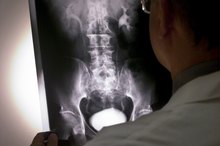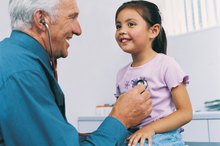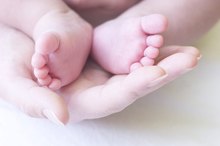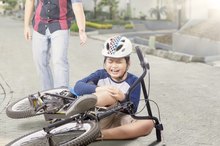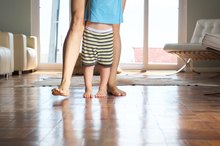Flat Feet in Teenagers
Failure of the arch of the foot to develop fully can cause flat feet in your teenager. Although not a serious medical condition, flatfoot can cause pain and may make activities that involve long periods of standing uncomfortable. Using special shoe inserts to support the foot may be all that is needed to relieve symptoms, although in rare cases, your doctor may recommend surgery.
If you are experiencing serious medical symptoms, seek emergency treatment immediately.
Identification
Pediatric flatfoot occurs when the arch on the underside of the foot is absent or abnormally low. Although flatfoot is common and usually painless in babies and young children, it can cause cramps and pain in the arch or heel in older children and teenagers. Pain or cramping may also occur in the knee and leg. Flatfoot can affect one or both feet. Children with flat feet may walk awkwardly and may have difficulty finding comfortable shoes to wear.
- Pediatric flatfoot occurs when the arch on the underside of the foot is absent or abnormally low.
- Pain or cramping may also occur in the knee and leg.
Types
Orthopedic Shoes for Scoliosis
Learn More
Flexible flatfoot occurs when the foot remains supple and the Achilles tendon isn’t tight. Although the arch looks flat when your child stands normally, an arch is visible when your child stands on her toes. The American Academy of Orthopaedic Surgeons reports that a flexible flatfoot has normal muscle function and good joint mobility, and is considered to be a variation of normal 13. If your child has rigid flatfoot, the arch remains flat despite changing the position of the foot. Children who have a flat foot with tight heel cord can’t bend the foot at the ankle more than 15 degrees.
- Flexible flatfoot occurs when the foot remains supple and the Achilles tendon isn’t tight.
Sports Participation
Although it was once thought that children and teenagers with arch problems may have difficulty participating in sports, Anton Tudor, M.D. and other researchers found that children with flexible flatfoot perform activities just as well as children with normal arches. Two-hundred and eighteen children were tested while performing 17 types of athletic movements, including balance, hopping and repetitive leg movements. The study, “Flat-footedness Is Not a Disadvantage for Athletic Performance in Children Aged 11 to 15 Years,” was published in the March 2009 issue of “Pediatrics. 2”
- Although it was once thought that children and teenagers with arch problems may have difficulty participating in sports, Anton Tudor, M.D.
- and other researchers found that children with flexible flatfoot perform activities just as well as children with normal arches.
- The study, “Flat-footedness Is Not a Disadvantage for Athletic Performance in Children Aged 11 to 15 Years,” was published in the March 2009 issue of “Pediatrics.
Treatment
My Child Is Complaining of Pain in His Legs
Learn More
No treatment is needed if your teenager’s flat feet don’t cause any problems. Wearing heel cups or orthotic shoe inserts may be helpful in supporting the foot and reducing pain and cramping. Although doctors don’t recommend any particular type of shoe for teenagers with flatfoot, they suggest wearing well-fitting shoes with good arch support. Wearing shoes or sandals that lack adequate arch support may increase pain. If prolonged walking or standing or participation in certain activities causes pain, your doctor may suggest that your child temporarily decrease his activities, according to the American College of Foot and Ankle Surgeons 3. Taking over-the-counter anti-inflammatory pain medication or performing stretching exercises may help relieve pain. Children who have rigid flatfoot or flatfoot with a tight heel cord may require surgery to relieve pain and improve the functioning of the foot.
- No treatment is needed if your teenager’s flat feet don’t cause any problems.
- If prolonged walking or standing or participation in certain activities causes pain, your doctor may suggest that your child temporarily decrease his activities, according to the American College of Foot and Ankle Surgeons 3.
Related Articles
References
- American Academy of Orthopaedic Surgeons: Flexible Flatfoot in Children
- "Pediatrics" journal; Flat-Footedness Is Not a Disadvantage for Athletic Performance in Children Aged 11 to 15 Years; Anton Tudor, M.D.; March 2009
- American College of Foot and Ankle Surgeons: Pediatric Flatfoot
- Gross KD, Felson DT, Niu J, Hunter DJ, Guermazi A, Roemer FW, Dufour AB, Gensure RH, Hannan MT. "Association of flat feet with knee pain and cartilage damage in older adults." Arthritis Care Res (Hoboken). 2011 Jul;63(7):937-44. doi: 10.1002/acr.20431.
- Press Release "New clinical practice guideline published to treat flat feet in adults." American College of Foot and Ankle Surgeons, March 5, 2005
Writer Bio
Working at a humane society allowed Jill Leviticus to combine her business management experience with her love of animals. Leviticus has a journalism degree from Lock Haven University, has written for Nonprofit Management Report, Volunteer Management Report and Healthy Pet, and has worked in the healthcare field.
